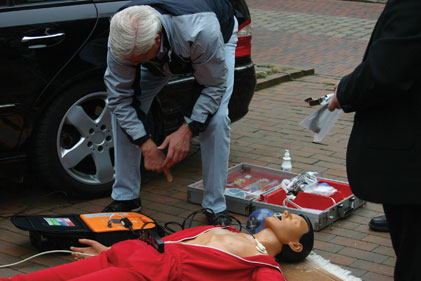OSHA does not have standards specific to AEDs. However, exposures to first-aid hazards are addressed in specific standards for the general industry.
Most sudden cardiac deaths occur outside of the hospital. Chances of survival from sudden cardiac death diminish by 7 to 10 percent for each minute without immediate CPR or defibrillation. After 10 minutes, resuscitation rarely succeeds. Public access defibrillation (PAD) programs that place automated external defibrillators (AEDs) in areas where cardiac arrests may occur can reduce the response time up to three to five minutes. In a study of PAD, communities with volunteers trained in CPR and the use of AEDs had twice as many victims survive compared to communities with volunteers trained only in CPR.1
In OSHA’s Best Practice Guide, “Fundamentals of a Workplace First Aid Program,” the agency says that all worksites are potential candidates for AED programs because of the possibility of sudden cardiac arrest (SCA) and the need for timely defibrillation. Each workplace should assess its own requirements for an AED program as part of its first-aid response.
A number of issues should be considered in setting up a worksite AED program: physician oversight; compliance with local, state and federal regulations; coordination with local EMS; a quality assurance program; and a periodic review, among others. Although AEDs are easy to use, proper training is imperative.
All about training
According to the National Center for Early Defibrillation (NCED)2, learning to use an AED is highly intuitive and surprisingly simple. Current AED courses usually last about three to four hours to allow ample time for hands-on practice and to help increase user competence and confidence. AED training and related resources are offered through the American Heart Association, the American Red Cross, EMP America, the National Safety Council and others. AED manufacturers also offer training resources.
AED training curricula vary, but generally emphasize:
A working knowledge of CPR
Safety for both victims and rescuers
Proper placement of electrodes
Delivering the first shock as quickly as possible, ideally within 60 seconds from time of arrival at the victim’s side
Plenty of hands-on practice, with one instructor and one AED or AED trainer for every four to six students
Sample AED class outline
Prerequisite: CPR training
Distribute course materials to students two weeks prior to class. Course materials may include instructional booklets and videos, local AED protocols, skills checklists, and operating guidelines for the specific device that will be used.
Present introductory lecture. (20 minutes)
Demonstrate how to use the AED. (20 minutes)
Review local AED treatment protocols. (20 minutes)
Supervise practice. Each student should have the opportunity to manage at least three scenarios. (60 minutes)
Discuss medical direction, device maintenance, continuing education, documentation and quality assurance. (15 minutes)
Administer written evaluation. (Optional) (30 minutes)
Administer practical evaluation following skills checklist. (60 minutes)
Provide remedial training for those who do not successfully complete evaluation process.
How to use an AED
AED protocol has seven basic steps.
1) Check unresponsiveness.
2) Call 9-1-1 or the local emergency number (if applicable) and retrieve the AED.
3) Open the airway and check for breathing. If there is no breathing or breathing appears abnormal, give two slow breaths.
4) Check for a pulse. If there is no pulse, turn on the AED. A second rescuer should continue CPR until the AED is attached.
5) Attach the AED electrode pads.
6) Analyze the heart rhythm. Make sure no one is touching the victim.
7) Press the “shock” button, if advised. Make sure no one is touching the victim.
(For a more detailed description of these seven steps, visit the NCED website at www.early-defib.org.)
Words of caution
AEDs are safe and effective when used properly. Follow the operating instructions that come with each AED. For all AEDs, there are basic precautions:
Attach the AED only to victims who are unresponsive, who are not breathing normally and who have no pulse.
AEDs, as currently configured, are intended for use among adult victims of sudden cardiac arrest, not children. If the victim appears to be less than eight years old or appears to weigh less than 25 to 30 kg. (55 to 65 lbs.), do not attach the AED.
It is safe to use AEDs in all weather conditions, including rain and snow. In wet weather, wipe the chest dry before placing electrodes. If the victim is lying in water, move him or her to a relatively dry area before attaching the AED.
Never place AED electrode pads directly on top of medication patches, such as nitrogylcerin. Patches should always be removed and the skin wiped dry before placing defibrillator pads on the skin. Make sure to wipe your own skin dry if you come in contact with the medication.
If the victim has a pacemaker or an internal defibrillator with a battery pack (visible as a lump under the skin about two inches long), avoid placing pads directly on top of the implanted medical device, if it is possible to do so and still maintain proper pad placement.
If the victim is lying on a metal surface, such as bleachers or a stretcher, avoid contact of the electrodes with the metal surface.
Refresher training
It is important to review AED skills on a regular basis. Most experts recommend every three to four months.
Use brief sessions (about 30 to 60 minutes long) to review AED operation and maintenance and standing orders, practice protocols using various scenarios, critique recent cases and evaluate skills. As an alternative to classroom review sessions, computer-based interactive training is available from some AED manufacturers.
Training costs
AED training costs vary. One factor affecting costs is whether personnel are paid for training time or training is done on a voluntary basis. Another factor is whether actual field AEDs or less expensive AED trainers are used for training. Since initial and refresher training require relatively little time, costs are typically minimal. Organizations that appreciate the value of early defibrillation consider AED training costs a worthwhile investment.
References
1. Hallstrom, A. and J. Ornato. “Public-Access-Defibrillation and Survival after Out-of-Hospital Cardiac Arrest.” New England Journal of Medicine 351.7(2004, August 12): 637-646.
2. National Center for Early Defibrillation, www.early-defib.org.







